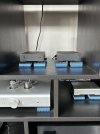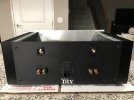I think that ultimately the PFFB applied to stereo is going to provide consumers (us) with very high quality for low price.Welcome to ASR!
The figures shown are from the TI's TPA3255 datasheet. The first figure is the max output (at 1% THD+N) when used in the stereo (2 output channels) mode. The blue dotted line indicates the supply voltage of 48 VDC. With 4 Ω load (black curve), the output is ~230 W. Assuming that the amp has reached is maximum output current with 4 Ω load, the maximum output with 3 Ω load is 230 * (3/4) = 173 W. (Since power = current^2 × load impedance, and when current limit is reached, max output power is drops with the load impedance.) The 173 W estimate is conservative as the current limit is likely not an abrupt hard limit, and the stereo amp can probably output a bit more than 173 W (1 % THD+N).
View attachment 381599
The second figure is for the mono (1 output channel) mode. With 4 Ω load (gray curve), the max output is marginally increased to ~255 W (~0.5 dB increase, a likely-not-noticeable difference). But since the current output capacity is doubled for the mono mode, the 3 Ω (red curve) max output is increased to 325 W, which is about 2.7 dB (at most) more than the stereo mode.
The summary is that there is little benefit if load impedance is over 4 Ω, with the mono setup the heat dissipation will be distributed to 2 amps instead of 1 and therefore less stress for the monos when power output demands are high. You'll need to decide for yourself whether the optimistic estimate of 2.7 dB power increase at 3 Ω is worth going with 2 monos vs 1 stereo.
View attachment 381594
I am still listening to my new monos just received.
Hi, does anyone here have experience with a Schiit Magni (any generation) as a preamp/volume control for the V3 Mono’s? From what I can find, this should work good together.
I also received one of these balanced volume controls separately
and in combination with the v3 monos this relay volume control is very very (very) good indeed (obviously my subjective opinion).
This is a relay balanced volume control and I suspect very close to the Schitt Freya in passive mode and the Schitt Kara also.
IF you are using a balanced output dac with output >= 4v approx, or a phono preamp likewise (iFi phono for example) to drive your v3 monos then one of these is well worth considering. I am frankly amazed.
I am not sure what the difference is between one of these adjusting volume with a balanced driver upstream vs a Freya 2 with it's no gain but actively driven option.
If you are going unbalanced then a Schiit Magni (I have not experience but in theory) should be very good also.












